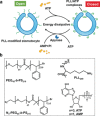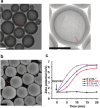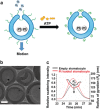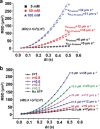ATP-Mediated Transient Behavior of Stomatocyte Nanosystems
- PMID: 31267638
- PMCID: PMC7079195
- DOI: 10.1002/anie.201906331
ATP-Mediated Transient Behavior of Stomatocyte Nanosystems
Abstract
In nature, dynamic processes are ubiquitous and often characterized by adaptive, transient behavior. Herein, we present the development of a transient bowl-shaped nanoreactor system, or stomatocyte, the properties of which are mediated by molecular interactions. In a stepwise fashion, we couple motility to a dynamic process, which is maintained by transient events; namely, binding and unbinding of adenosine triphosphate (ATP). The surface of the nanosystem is decorated with polylysine (PLL), and regulation is achieved by addition of ATP. The dynamic interaction between PLL and ATP leads to an increase in the hydrophobicity of the PLL-ATP complex and subsequently to a collapse of the polymer; this causes a narrowing of the opening of the stomatocytes. The presence of the apyrase, which hydrolyzes ATP, leads to a decrease of the ATP concentration, decomplexation of PLL, and reopening of the stomatocyte. The competition between ATP input and consumption gives rise to a transient state that is controlled by the out-of-equilibrium process.
Keywords: ATP; nanomotors; nanoreactors; out-of-equilibrium systems; stomatocytes.
© 2019 Wiley-VCH Verlag GmbH & Co. KGaA, Weinheim.
Conflict of interest statement
The authors declare no conflict of interest.
Figures







Similar articles
-
Adenosine Triphosphate Harnessed Transient Aggregations of Nanoparticles for Efficient Nanoreactors in Water.Langmuir. 2025 Apr 15;41(14):9574-9580. doi: 10.1021/acs.langmuir.5c00842. Epub 2025 Apr 3. Langmuir. 2025. PMID: 40177889
-
Redox-Sensitive Stomatocyte Nanomotors: Destruction and Drug Release in the Presence of Glutathione.Angew Chem Int Ed Engl. 2017 Jun 19;56(26):7620-7624. doi: 10.1002/anie.201703276. Epub 2017 May 22. Angew Chem Int Ed Engl. 2017. PMID: 28489266 Free PMC article.
-
Synthetic syntrophy for adenine nucleotide cross-feeding between metabolically active nanoreactors.Nat Nanotechnol. 2025 Jan;20(1):112-120. doi: 10.1038/s41565-024-01811-1. Epub 2024 Oct 21. Nat Nanotechnol. 2025. PMID: 39433918 Free PMC article.
-
[Transformations of erythrocytes shape and its regulation].Postepy Biochem. 2009;55(4):425-33. Postepy Biochem. 2009. PMID: 20201356 Review. Polish.
-
Modular Engineering of Aptamer-Based Nanobiotechnology for Conditional Control of ATP Sensing.Adv Mater. 2024 May;36(22):e2302972. doi: 10.1002/adma.202302972. Epub 2023 Nov 27. Adv Mater. 2024. PMID: 38009471 Review.
Cited by
-
Adaptive Polymeric Assemblies for Applications in Biomimicry and Nanomedicine.Biomacromolecules. 2019 Nov 11;20(11):4053-4064. doi: 10.1021/acs.biomac.9b01341. Epub 2019 Oct 31. Biomacromolecules. 2019. PMID: 31642319 Free PMC article.
-
Inherently Fluorescent Peanut-Shaped Polymersomes for Active Cargo Transportation.Pharmaceutics. 2023 Jul 20;15(7):1986. doi: 10.3390/pharmaceutics15071986. Pharmaceutics. 2023. PMID: 37514172 Free PMC article.
-
Polymersome-based nanomotors: preparation, motion control, and biomedical applications.Chem Sci. 2025 Apr 3;16(17):7106-7129. doi: 10.1039/d4sc08283d. eCollection 2025 Apr 30. Chem Sci. 2025. PMID: 40206551 Free PMC article. Review.
-
Non-equilibrium self-assembly for living matter-like properties.Nat Rev Chem. 2024 Oct;8(10):723-740. doi: 10.1038/s41570-024-00640-z. Epub 2024 Aug 23. Nat Rev Chem. 2024. PMID: 39179623 Review.
-
Recent Advances in the Synthesis and Application of Polymer Compartments for Catalysis.Polymers (Basel). 2020 Sep 24;12(10):2190. doi: 10.3390/polym12102190. Polymers (Basel). 2020. PMID: 32987965 Free PMC article. Review.
References
-
- None
-
- Guix M., Mayorga-Martinez C. C., Merkoçi A., Chem. Rev. 2014, 114, 6285–6322; - PubMed
-
- Ren L., Wang W., Mallouk T. E., Acc. Chem. Res. 2018, 51, 1948–1956; - PubMed
-
- Wang J., Gao W., ACS Nano 2012, 6, 5745–5751; - PubMed
-
- Sengupta S., Patra D., Ortiz-Rivera I., Agrawal A., Shklyaev S., Dey K. K., Córdova-Figueroa U., Mallouk T. E., Sen A., Nat. Chem. 2014, 6, 415–422; - PubMed
Publication types
MeSH terms
Substances
Grants and funding
- VICI grant/Dutch Science Foundation/International
- Gravitation program 024.001.035/Dutch Min-istry of Education, Culture and Science/International
- Nanomed, (No. 676137)/European Union's Horizon 2020 research and innovation programme Marie Sklodowska Curie Innovative Training Networks/International
- ERC Advanced grant Artisym 694120/ERC_/European Research Council/International
LinkOut - more resources
Full Text Sources

